- Author Matthew Elmers [email protected].
- Public 2023-12-16 21:49.
- Last modified 2025-06-01 06:23.
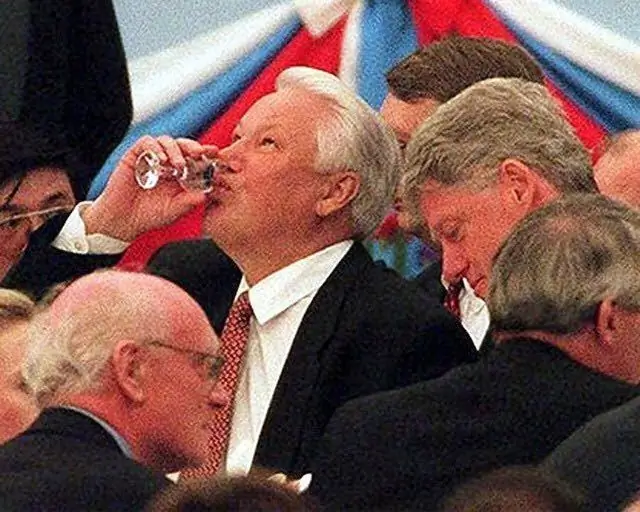
In this article, we will talk a little about the state of affairs with alcohol consumption in Russia after the collapse of the USSR.
Dashing 90s
The 90s of the twentieth century have become one of the most terrible in the history of Russia. In addition to large-scale economic losses, our country, in the absence of a big war and "friendship" with traditional geopolitical rivals, suffered huge demographic losses. The unprecedented alcoholization of the population also played a significant role in this tragedy. And one of the symbols of this fall was the shameful drunkenness of the first president of Russia.
A separate article could be written about B. Yeltsin's alcohol addictions and his outstanding achievements in this area. But there is no particular need for it. Those wishing to find information on this topic can refer, for example, to A. Korzhakov's book “B. Yeltsin, from dawn to dusk "(chapter" Operation Sunset "). And in other, later sources, you can find a lot of interesting information. One way or another, the "small need" he coped on the wheel of an airplane in the USA, the "great standing" of the President of Ireland at the Shannon airport, drunken dancing on stage during the 1996 election campaign and "conducting" the orchestra in Berlin in 1994 - it has gone down in history and folklore of our country forever.
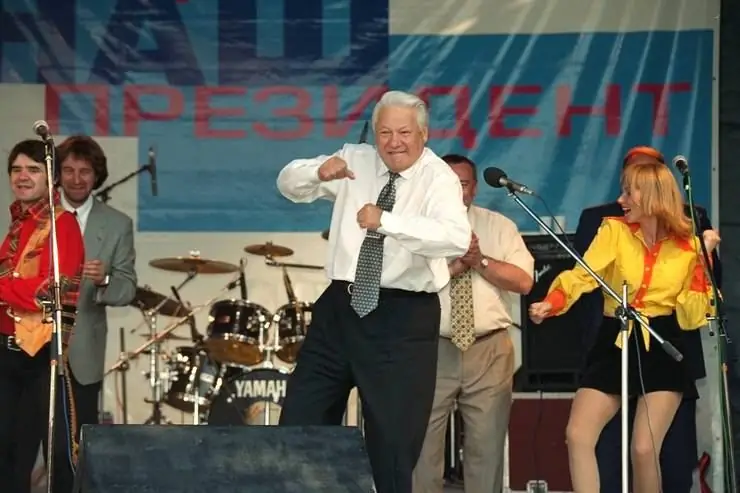
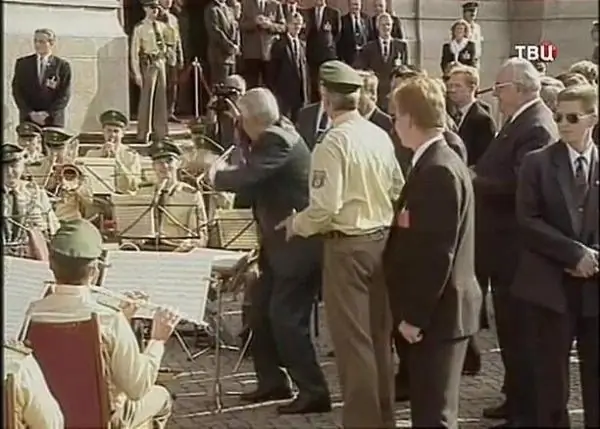
Under Yeltsin, the state monopoly on the production and sale of alcoholic beverages was once again destroyed (decree of June 7, 1992). On the one hand, this led to huge losses for the country's budget, on the other, to an unprecedented increase in the production of low-quality alcoholic beverages. By order of the new owners who were striving to get the maximum profit, even the most famous and advanced distilleries of the country switched to work with low-quality raw materials. It was not expensive vintage wines that poured into the country from abroad, but surrogates like the technical alcohol "Royal". An unprecedented advertising campaign of all kinds of alcoholic beverages (as well as cigarettes) was unleashed on television, which dealt the main blow to the new generation that was just entering life. The age of drinking alcohol has decreased over 10 years (from 1993 to 2003) from 16 to 13 years.
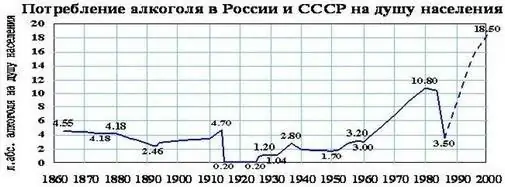
In 1998, a museum of the history of vodka was opened in Uglich, and in 2001, one such museum appeared in St. Petersburg. These museums are more likely to promote vodka than educate, especially the St. Petersburg one, united with "Ryumochnaya No. 1".
The number of patients with alcoholic hepatitis and cirrhosis increased sharply, and many of them were very young people (under 30 years old). People of the older generation tried to drown out with alcohol the pain of losing their jobs, suddenly falling into poverty, the bitterness of a ruined life, they tried to forget, at least for a short time, about the triumph of bandits, thieves, officials and speculators - and quickly died. Petr Aven, the former Minister of Finance and Deputy Prime Minister of the Yeltsin government of Russia, of course, was very cunning (to put it mildly) when, in April 2021, he suddenly announced:
“There is a legend that all the money that was in savings books was wasted by the Gaidar government. It wasn't like that."
And further:
"Almost all the funds from the deposits were spent by the government of Valentin Pavlov, while under Yegor Gaidar there was a" minuscule "that was eaten by inflation."
It is a very naive and it is not clear who was a calculated attempt to rehabilitate both myself and the "dashing 90s". Another thing is Anatoly Chubais, who, like a drunken man, “what is on his mind is on his tongue”. Back in 2001, he condescendingly stated:
“We were not engaged in collecting money, but in the destruction of communism … It does not matter how much we sold the factories for in the 90s, the main thing is that we destroyed communism. And we knew that every plant sold was a nail in the coffin of communism. Is it expensive, cheap, free, with a surcharge - the twentieth question, the twentieth … We gave the property to those who were closer to it. Bandits, secretaries of regional committees, directors of factories."
As the saying goes, "confession" and "sincere confession." But where is the now hated "privatizer" of Russia? No, not in a prison, and not even in a London mansion or a villa in Marbella: he continues to work as an "effective manager". The degree of "efficiency" of this character can be judged by the article in "Komsomolskaya Pravda" with the eloquent title "Chubais Gone - Income Came": the revenue of Rusnano for the 1st quarter of 2021 amounted to almost 15 billion rubles (15 times more than the same period last year), net profit - 6 billion rubles (an increase of 37 times):

Cheerful reformers of the "dashing 90s": P. Aven and A. Chubais.
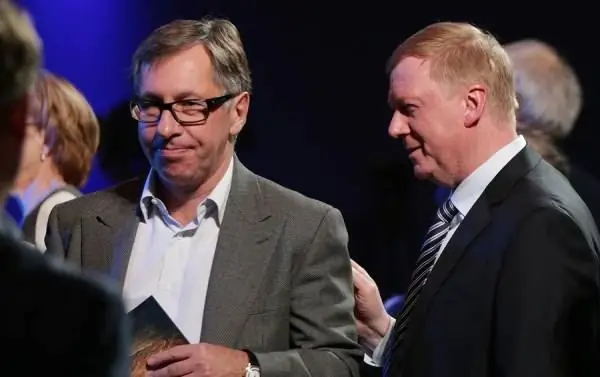
Historians have yet to calculate the number of victims of these would-be reformers.
The fight against alcohol advertising was painful and long.
On July 18, 1995, it was forbidden to advertise alcoholic beverages on television and radio from 7 am to 10 pm, as well as in programs for children.
On January 1, 1996, advertising of strong alcohol was banned, but manufacturers began to promote not finished products on TV, but recognizable trademarks.
From November 11, 1999, there was a requirement to indicate in advertising the harm of using any alcoholic beverages.
Since September 5, 2004, beer advertisements have been banned during the daytime.
Advertising of alcohol on the radio has been banned since March 13, 2006.
On July 23, 2012, a ban was introduced on advertising of all alcohol-containing products - and advertising of non-alcoholic beer of well-known brands appeared.
Then an exception was made for beer for the period of the World Cup.
But we got ahead of ourselves. Let's remember the "dashing 90s" again.
By mid-1993, the would-be reformers, who had previously abolished the state monopoly on the production and trade of alcoholic beverages, realized their mistake.
On June 11 of that year, an attempt was made to restore the state monopoly. But by this time the market had already been seized by private enterprises, which still control it.
On April 14, 1994, by a government decree, excise duty stamps were introduced in Russia, which verify the payment of all taxes, confirm the quality of the alcoholic product and its compliance with applicable standards.
New Year's Holidays
Before the revolution, the Orthodox Church officially considered September 1 as New Year's day. January 1 was considered a secular holiday and only June 2, 1897 was declared a day off. This date was also considered a religious holiday - the Circumcision of the Lord. After the revolution, Christmas became a working day; the new authorities kept the day off on January 1. From 1929 to 1947 January 1 was no longer considered a holiday (it fell under the "fight against religious prejudices"). Then the first day of the new year became festive again.
On September 25, 1992, by a decree of the government of the Russian Federation, new holidays were introduced - Christmas (January 7) and January 2.
From December 29, 2004, the days from January 1 to January 5, inclusive, became holidays. Since 2013, the New Year holidays have been extended: the days from January 1 to January 8 have been declared holidays. In 2021, the day off from January 3, 2022 will be postponed to December 31.
The majority of narcologists and doctors of other specialties have an extremely negative attitude to this "vacation". It is fairly pointed out that the prices for any vacation (both in Russia and abroad) literally "take off" during this period, becoming inaccessible to the vast majority of our fellow citizens. The weather at this time, even in the south of the country, is cold, it is uncomfortable to be outside for a long time. As a result, Russians sit at home watching TV, drinking huge amounts of alcohol (while drinking much more money than they expect) and eating much more than on ordinary days. The result is very sad: it is estimated that in the period from 1 to 17 January, every year "additionally" in Russia die from 9 to 12 thousand people. The causes of death are "drunken" injuries and murders (the number of murders increases by 70%), poisoning, pancreatic necrosis, cardiovascular diseases, hypothermia and associated pneumonia. The most "terrible" is January 1 - on this day, on average, 2,200 people die "additionally". The second peak in mortality occurs on January 7th. Moreover, among those who died on New Year's holidays, people aged 35 to 55 predominate. About 78% of them are men, and up to 22% are women. It is interesting that other holidays (February 23, March 8, May 1 and 9) give a significantly smaller (and also short-term) increase in mortality - up to 3 thousand people on these days.
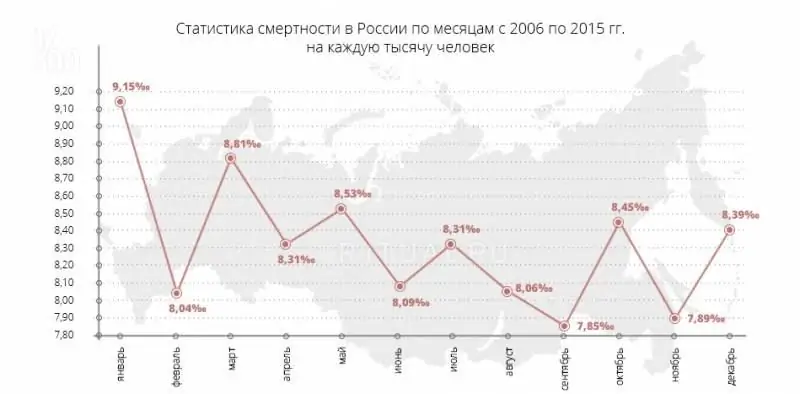
Quite sensible proposals have been voiced for a long time to postpone the "vacation" to the first ten days of May, when many people will be able to devote this time not to banal drinking, but to work in vegetable gardens and dachas. Yes, and short-term independent tourist trips without booking hotels that have risen in price are much more pleasant to make when temperatures are above zero. It seems quite reasonable to postpone one of the New Year's days to September 1, when half of the country still runs away from work under any pretext to take the children to school. However, the Russian government stubbornly ignores the problem.
Sobering-ups
From the previous article, we remember that the first Soviet sobering-up station was opened in Leningrad in 1931. Then they appeared in other large Soviet cities. In 2011, sobering-up centers in Russia were closed. This rash decision led to a number of problems. The number of people robbed in a helpless state has increased. During the winter months, the number of deaths from hypothermia and severe frostbite increased. On the other hand, they began to bring drunk people to general hospitals, which did not please either the staff on duty or the sick. Indeed, is it pleasant for a person who is being treated for pain in the heart, high blood pressure or any other disease to have a swearing drunkard who suddenly found himself on the next bed in the middle of the night? And can you count on any help from the fragile nurse on duty and the nurse grandmother? It took Russian parliamentarians 10 years to correct this mistake. Since January 1, 2021, sobering-up stations have reappeared in our country. But now they charge a fee for staying in them.
Alcohol consumption in modern Russia
What is the situation with alcohol consumption in modern Russia? It may seem unexpected, but, according to narcologists, it is gradually improving. There has been a clear trend towards a decrease in the consumption of strong alcoholic beverages and an increase in the consumption of low-alcohol beverages. Vodka in Russia has ceased to be the most popular alcoholic drink, giving way to beer, which is now bought 9 times more often. Moreover, in parallel with the decrease in sales of vodka and other spirits, the consumption of grape wine is growing in Russia. And the total alcohol sales for 5 years from 2012 to 2016, according to retail chains, decreased by 2.5 times. Stories about ever-drunk Russian tourists in hotels operating on the "All Inclusive" system go into the category of ancient, no longer relevant and not funny anecdotes. Much more often now in the resorts you can see drunk Germans or Englishmen. The culture of consumption of high-quality alcoholic beverages is gradually developing. Moonshine is becoming less relevant even in villages. Nowadays only people of the older generation are able to "drive moonshine" according to old traditional recipes and technologies, young people do not seek to learn from their experience, preferring to buy ready-made alcoholic beverages. Although, on the other hand, some "enthusiasts" are quite successfully experimenting with new recipes, getting fairly high-quality homemade liqueurs and wines.
2008 to 2018 mortality from alcohol intoxication decreased by 3.5 times (from 13.6 to 3.8 per 100 thousand people). The number of alcoholics during this time decreased by 37% (alcoholics in Russia decreased by 778, 1 thousand people). The incidence of alcoholism and alcoholic psychoses decreased by 56.2%.
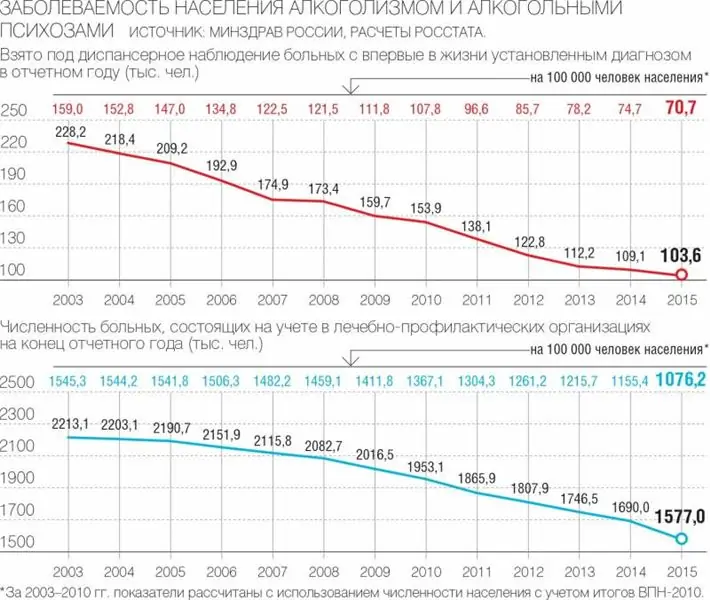
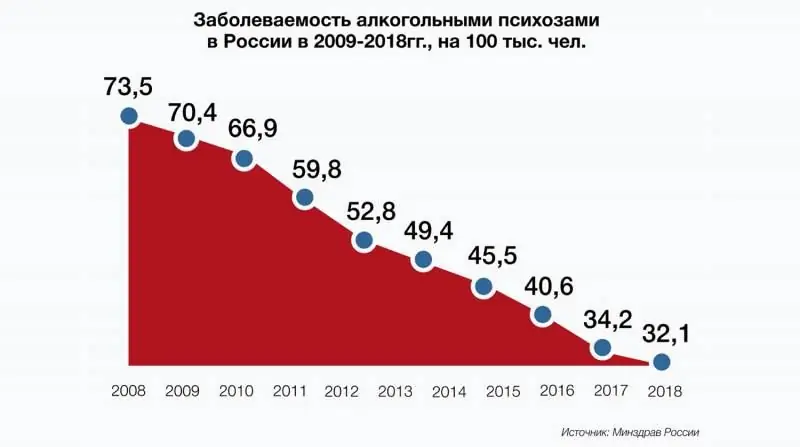
The mortality rate from "drunken" road accidents has decreased by 2 times. The number of newly diagnosed alcoholic hepatitis, cirrhosis, cardiopathy, pancreatic necrosis, encephalopathy and other diseases associated with alcohol consumption has significantly decreased. Decreased mortality from alcohol poisoning:
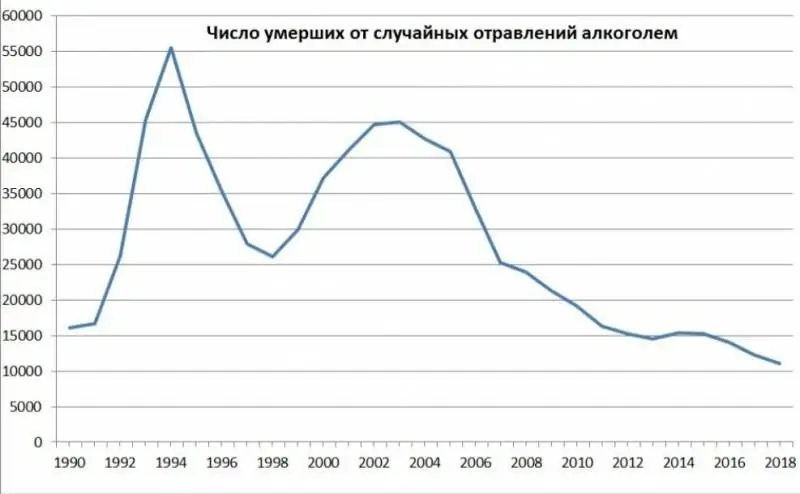
Here's how alcohol consumption changed in Russia from 2008 to 2016:

Of course, alcohol consumption varies greatly in different regions of the Russian Federation. According to the rating compiled in 2016, the most "drinkers" were the Magadan Region, the Chukotka Autonomous District, the Komi Republic, the Amur Region, the Perm Territory, Karelia, Buryatia, the Sakhalin Region, the Nizhny Novgorod Region, Kamchatka, and the Kirov Region.
The most "sober" are the Chechen Republic, Ingushetia, Dagestan, Karachay-Cherkessia, Kabardino-Balkaria, Kalmykia, Stavropol Territory, Belgorod Region, North Ossetia, Rostov Region.
Moscow is in 28th place in this rating. The consumption of vodka in the capital is 2-3 times less than in other large cities, the consumption of beer is 2 times less than the average in Russia, but the average Muscovite, on the contrary, drinks 2 times more wine. And the Samara Region became the leader in beer consumption per capita in 2016: this indicator here turned out to be 5 times higher than in Moscow. And here is how, according to Rosstat, the purchases of alcoholic beverages by residents of the Volgograd region have changed from 2007 to 2014.
Vodka and alcoholic beverages in 2007 were drunk here 8.6 liters per capita, in 2010 - 6, 87, in 2014 - 4, 32. Consumption of cognac slightly increased - from 0, 4 in 2007 to 0.61 in 2014. Consumption of grape wines increased from 4.9 liters per capita in 2007 to 5.5 in 2014, sparkling wines - from 1.9 to 2. 28. Beer consumption in 2007 was 75 liters per capita. The maximum was reached in 2012 (79, 3), and in 2014 its consumption decreased to 71.3 liters per person.
The incidence of alcoholism and alcoholic psychoses by federal districts in 2009:
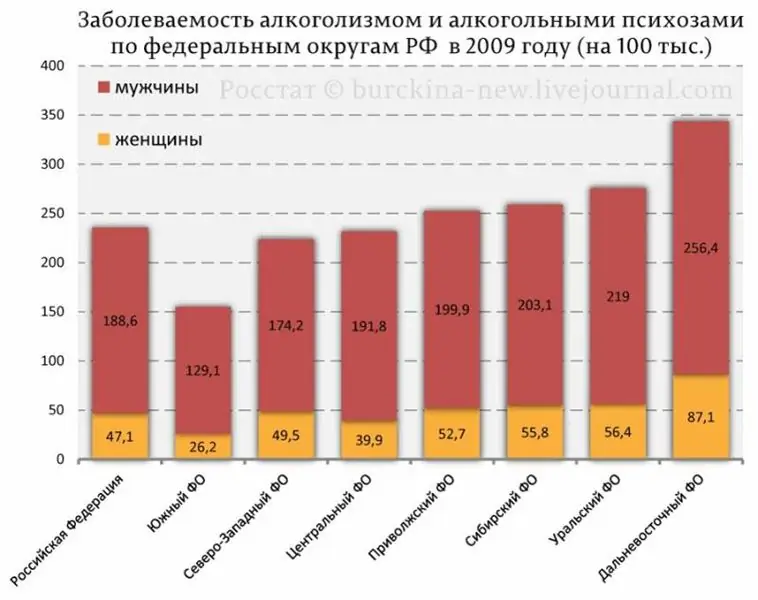
The ratio of alcohol consumption and life expectancy for men in Russia in 1965-2018:

According to VTsIOM, in 2017, 39% of Russians called themselves nondrinkers, 38% - drinking alcohol 1 or less once a month. In 2019, according to WHO, 27% of Russians over 15 years old said they had never drank alcohol in their lives, and 15% said they had "quit drinking."
In 2018, sales of beer in Russia increased by 4%, wine - by 7%, and sales of vodka decreased by 2%. In a month that year, the average Russian bought 10 bottles of beer, a bottle and a half of spirits and a bottle of wine.
However, in 2020, per capita consumption of vodka in Russia increased by 2%, beer - by 4.4%, and total alcohol sales increased by 1.3%. Experts attribute this to the so-called "pandemic" of the new coronavirus infection. On the one hand, alcohol consumption increased sharply during the period of "self-isolation", when people who fell out of their usual way of life drank, as they say, "out of nothing to do." On the other hand, the use of alcohol for some has become a kind of "cure for stress" caused by the flow of negative information associated with the same "pandemic". And this despite the fact that, according to a number of experts, the epidemic threshold for this disease has not been exceeded in any country in the world (for respiratory infections, the epidemic threshold is set at a level of at least 5% of all population of a country or region who are ill at a time, but for influenza, it may even be 20-25%). Therefore, we can say that in many respects the harm from anti-epidemic measures exceeded their benefit.
One way or another, there is reason for some optimism. The temporary workers of the "dashing 90s" did not succeed in destroying the foundations of Russian society: healthy forces prevailed. Of course, there is still a long way to go before a complete victory over the "Green Serpent" in Russia. But I would like to hope that, provided that development is calm and there are no cataclysms, these positive trends will continue in the future.






